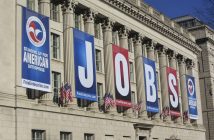In one fell swoop, the COVID-19 pandemic has brought the American economy to its knees and thrown many American workers out of their jobs. More than ten million Americans have lost their jobs in the last month, and St. Louis Federal Reserve President James Bullard estimates that before this is over, unemployment could reach 32 percent — that’s nearly ten percentage points higher than the 24.9 percent jobless rate the nation suffered during the worst of the Great Depression in 1933.
But many of those workers who are laid off will eventually seek to return to their jobs in the nation’s small business sector, comprised of some 31 million small businesses across the country. These small companies – ones with less than 500 employees – range from hairdressers to bookstores, from small factories to restaurants, and last year these companies employed 52 percent of all Americans who work for the private sector. And while Washington is trying to pull a new rabbit out of its hat to keep these entrepreneurs open, many may not be able to survive an extended COVID-19 shutdown.
Despite a potentially bleak future, marked by economic ruin and previously unseen unemployment rates, there’s one bad policy choice we can rely on the government to keep on making, albeit on a delayed basis, due to the pandemic. This nation will continue its historically high levels of immigration that are driven largely by chain migration. In 2019 the U.S. admitted:
- 1
million legal immigrants;
- 65,000 H-1B “high skilled workers;”
- 66,000 H-2B low skilled workers;
- 55,000 visa lottery immigrants;
- 25,000 refugees;
- 38,000 asylees.
And those numbers are just new admissions, they don’t include extensions of status or changes from one status to another by foreigners already in the United States.
Why would the U.S. continue admitting such an enormous number of immigrants when it knows – at least for the short term – that its economy will be in shambles and its own citizens will be in desperate need of work? Because our immigration system operates on autopilot, with congressionally mandated levels for each category. There is very little flexibility built into the system to allow the Executive Branch to respond to changing economic and political conditions throughout the world. It’s an outdated, immigration framework that operates in a vacuum, outside of the economic and political realities that affect the lives of everyday Americans.
The current immigration system is dysfunctional because it doesn’t address either international economics or geopolitics as they currently exist. Thankfully, as the Supreme Court affirmed in Trump v. Hawaii, the president has the ability to temporarily close the border to broad categories of immigrants in times of crisis. However, that power does not permit our Chief Executive to create new immigration classifications or do away with existing ones. America needs an immigration system that is flexible enough to meet the needs of our ever-changing economy.
And if ever there was a time to enact real immigration reform, it is now. Congress needs to stop forcing American workers to compete with foreigner workers for good jobs. It is time to make immigration policy work for Americans.




